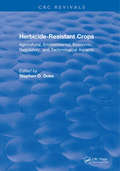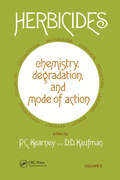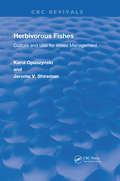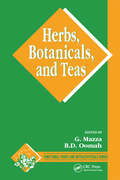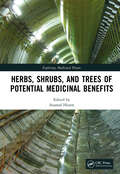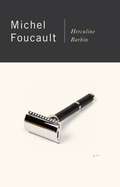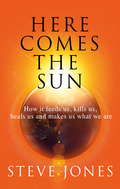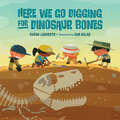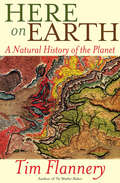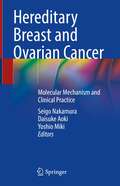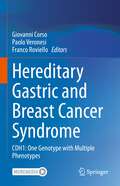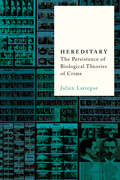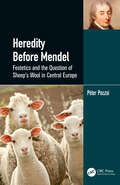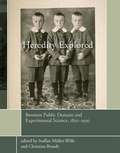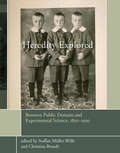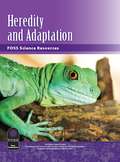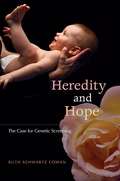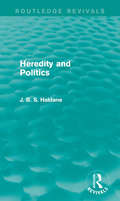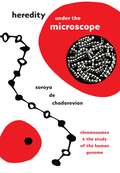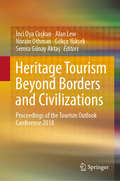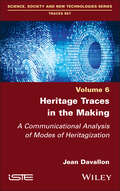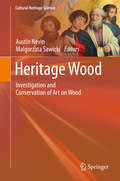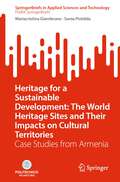- Table View
- List View
Herbicide-Resistant Crops: Agricultural, Economic, Environmental, Regulatory, and Technological Aspects
by Stephen O. DukeEdited by a recognized leader in the field, Herbicide-Resistant Crops is the first book to cover all of the issues related to the controversial topic of herbicide-resistant crops. It provides extensive discussions of the modern biotechnological methods that have been used to develop such crops, and reviews the implications - both positive and negative - of developing crops that are resistant to herbicides. The creation and anticipated applications of specific herbicide-resistant crops are also discussed. In addition, the book covers the potential impact of herbicide-resistant crops on weed management practices and the environment, and presents issues related to the regulation and economics of these crops. The editor has brought together a diverse group of professionals, representing the several distinct areas impacted by the new technology of herbicide-resistant crops. The wide range of viewpoints presented in this book creates a balanced and complete survey, providing a notable contribution to the literature.
Herbicides Chemistry: Degradation and Mode of Action
by P.C. Kearney D.D KaufmanVolume 3: Conveniently gathering up-to-date information on herbicides' chemistry, degradation, and mode of action in one source, this reference discusses glyphosatc and the traits that have made it so successful ... investigates the adsorption of polycyclic alkanoic acids' ester into targeted plants ... documents sulfonylureas' selectivity, environmental compatibility, groundwater safety, and low use rate ... explains metribuzin's combination with other herbicides to increase weed control for soybeans, potatoes, and tomatoes ... and examines alachlor and metolachlor for controlling annual grasses, broadleaf weeds, yellow nutscdge in corn, soybeans, and many other crops. Extensively referenced and illustrated, Herbicides, Volume 3 is an outstanding reference for soil scientists, agronomists, microbiologists, biochemists, agricultural chemists, botanists, environmental scientists, and plant nutritionists and pathologists.
Herbivorous Fishes: Culture and Use for Weed Management (Routledge Revivals)
by Karol Opuszynski, D.Sc Jerome V. Shireman, PhDPublished in 1995: This book is not designed as a culture manual for herbivorous fishes, but the reader is directed to other sources. This book should meet the needs that exist for a comprehensive publication on herbivorous fishes.
Herbs, Botanicals and Teas
by G. Mazza B. D. OomahHerbs, Botanicals and Teas presents the latest scientific and technical information on the chemical, pharmacological, epidemiological and clinical aspects of major herbal and tea products. Written by leading researchers contributing to the field, this is the first reference to provide in-depth coverage of garlic, ginseng, Echinacea, ginger, fenugre
Herbs, Shrubs, and Trees of Potential Medicinal Benefits (Exploring Medicinal Plants)
by Azamal HusenThere has been a worldwide increase in the demand for medicinal plants that aid the immune system, and considerable progress has been made in plant-based drug development. Herbs, Shrubs and Trees of Potential Medicinal Benefits examines how plants are used in the development of drugs preventing and treating cancer, hepatitis, asthma, influenza, HIV, and other diseases by manipulating a variety of bioactive molecules found in these plant parts. The book analyses how plants may strengthen human immunity, improve mood and brain function, enhance blood and oxygen circulation, boost the healing processes, and maintain blood pressure. Though many herbs, shrubs and trees have been identified for developing healthcare products, many of them require further exploration for potential usage. This volume in the Exploring Medicinal Plants series, presents information on herbs, shrubs and trees discussing traditional knowledge, chemical derivatives, and potential benefits of these items. Features: Identifies and highlights some medicinal herbs, shrubs and or trees around the world, presenting overall potential benefits to human health. Explores important medicinal plants for their bioactive constituents and phytochemicals. Discusses medicinal herbs, shrubs, and or trees for their uses in herbal drug preparation. Written by an international panel of plant scientists, this book is an essential resource to students, pharmacists, and chemists. It provides valuable information on fundamental chemical principles, modes of action, and product formulation of bioactive natural products derived from plants for medical applications.
Herculine Barbin: Being the Recently Discovered Memoirs of a Nineteenth-Century French Hermaphrodite
by Michel Foucault Richard McdougallWith an eye for the sensual bloom of young schoolgirls, and the torrid style of the romantic novels of her day, Herculine Barbin tells the story of her life as a hermaphrodite. Herculine was designated female at birth. A pious girl in a Catholic orphanage, a bewildered adolescent enchanted by the ripening bodies of her classmates, a passionate lover of another schoolmistress, she is suddenly reclassified as a man. Alone and desolate, he commits suicide at the age of thirty in a miserable attic in Paris. Here, in an erotic diary, is one lost voice from our sexual past. Provocative, articulate, eerily prescient as she imagines her corpse under the probing instruments of scientists, Herculine brings a disturbing perspective to our own notions of sexuality. Michel Foucault, who discovered these memoirs in the archives of the French Department of Public Hygiene, presents them with the graphic medical descriptions of Herculine's body before and after her death. In a striking contrast, a painfully confused young person and the doctors who examine her try to sort out the nature of masculine and feminine at the dawn of the age of modern sexuality. "Herculine Barbin can be savored like a libertine novel. The ingenousness of Herculine, the passionate yet equivocal tenderness which thrusts her into the arms, even into the beds, of her companions, gives these pages a charm strangely erotic. . . Michel Foucault has a genius for bringing to light texts and reviving destinies outside the ordinary. " Le Monde, July 1978
Here Comes the Sun
by Steve JonesOur sun drives the weather, forms the landscape, feeds and fuels - but sometimes destroys - the creatures that live upon it, controls their patterns of activity, makes chemicals in the skin that cheer up those who bask in its rays, and for the ancients was the seat of divine authority.In Here Comes the Sun, Steve Jones shows how life on Earth is ruled by our nearest star. It is filled with unexpected connections; between the need to stay cool and man's ability to stand upright, between the power of memory and the onset of darkness, between the flow of solar energy through the plants and animals and of wealth through society, and between Joseph Goebbel's 1938 scheme to make Edinburgh the summer capital of a defeated Britain and the widening gap in the life expectancy of Scottish men compared to that of other European men brought on by thnat nation's cloudy climate. Its author charts some of his own research in places hot and cold across the globe on the genetic and evolutionary effects of sunlight on snails, fruit-flies and people and shows how what was once no more an eccentric specialism has grown to become a subject of wide scientific, social and political significance. Stunningly evocative, beautifully written and packed full of insight, Here Comes the Sun is Steve Jones's most personal book to date.
Here Comes the Sun: How it feeds us, kills us, heals us and makes us what we are
by Professor Steve Jones'Illuminating!' Professor Brian Cox'Every Steve Jones book is a masterclass in clear and captivating writing with tantalising detours into beguiling anecdotes. Here Comes the Sun is dense with ideas and stories and, like all his books, it will change the way you see the world around you' Robin Ince Our sun drives the weather, forms the landscape, feeds and fuels - but sometimes destroys - the creatures that live upon it, controls their patterns of activity, makes chemicals in the skin that cheer up those who bask in its rays, and for the ancients was the seat of divine authority.In Here Comes the Sun, Steve Jones shows how life on Earth is ruled by our nearest star. It is filled with unexpected connections; between the need to stay cool and man's ability to stand upright, between the power of memory and the onset of darkness, between the flow of solar energy through the plants and animals and of wealth through society, and between Joseph Goebbel's 1938 scheme to make Edinburgh the summer capital of a defeated Britain and the widening gap in the life expectancy of Scottish men compared to that of other European men brought on by thnat nation's cloudy climate. Its author charts some of his own research in places hot and cold across the globe on the genetic and evolutionary effects of sunlight on snails, fruit-flies and people and shows how what was once no more an eccentric specialism has grown to become a subject of wide scientific, social and political significance. Stunningly evocative, beautifully written and packed full of insight, Here Comes the Sun is Steve Jones's most personal book to date.
Here We Go Digging for Dinosaur Bones
by Susan Lendroth"This is a perfect book for a dinosaur storytime." —School Library JournalThis STEM-friendly musical fossil dig will have dinosaur lovers singing along as they learn the science behind paleontology.Set to the tune of "Here We Go 'Round the Mulberry Bush," Here We Go Digging for Dinosaur Bones invites budding paleontologists and dinosaur fans on an exciting fossil dig. Readers will hike the trail, scan the ground, and make a find—then discover how to build a T. Rex from its bones.
Here on Earth: A Natural History of the Planet
by Tim FlanneryFrom the internationally acclaimed scientist, explorer, and conservationist comes an awe-inspiring account of earth&’s evolution. Beginning at the moment of creation with the Big Bang, Here on Earth explores the evolution of Earth from a galactic cloud of dust and gas to a planet with a metallic core and early signs of life within a billion years of being created. In a compelling narrative, Flannery describes the formation of the Earth&’s crust and atmosphere, as well as the transformation of the planet&’s oceans from toxic brews of metals (such as iron, copper, and lead) to life-sustaining bodies covering seventy percent of the planet&’s surface. Life, Flannery shows, first appeared in these oceans in the form of microscopic plants and bacteria, and these metals served as catalysts for the earliest biological processes known to exist. From this starting point, Flannery tells the fascinating story of the evolution of our own species, exploring several early human species—from the diminutive creatures (the famed hobbits) who lived in Africa around two million years ago to Homo erectus—before turning his attention to Homo sapiens. Drawing on Charles Darwin&’s and Alfred Russel Wallace&’s theories of evolution and Lovelock&’s Gaia hypothesis, Here on Earth is a dazzling account of life on our planet. &“You&’ll discover why Tim Flannery&’s books have made him the rock star of modern science.&” —Jared Diamond, Pulitzer Prize–winning author of Guns, Germs, and Steel
Hereditary Breast and Ovarian Cancer: Molecular Mechanism and Clinical Practice
by Seigo Nakamura Daisuke Aoki Yoshio MikiThis highly informative and clearly written book presents the basic science and the latest data on hereditary breast and ovarian cancer (HBOC) to provide an up-to-date and holistic overview of the disease. It starts off by presenting the molecular mechanisms, genetic testing and counseling, and variants of unknown significance (VUS) to help readers understand the contemporary interpretation of the disease. Further chapters focus on the surveillance, diagnosis and treatment, including chemoprevention, risk reduction and drug development based on molecular mechanisms. It also includes a chapter on the latest findings from the HBOC database, ethical issues and the parp inhibitors, and discusses innovative thinking to manage and understand the disease. Hereditary Breast and Ovarian Cancer - Molecular Mechanism and Clinical Practice offers breast surgeons, medical oncologists, gynecological oncologists and genetic counselors a comprehensive overview of the disease. Providing insights into recent scientific findings and further avenues for investigation, it is also a thought-provoking and informative read for researchers and scholars.
Hereditary Gastric and Breast Cancer Syndrome: CDH1: One Genotype with Multiple Phenotypes
by Franco Roviello Giovanni Corso Paolo VeronesiIn this book the editors and authors provide a comprehensive overview on basic research and clinical aspects of hereditary breast and gastric tumors. In particular, this updated editorial work aims to suggest guidelines for the clinical management of patients with hereditary diffuse gastric and lobular breast cancer. Special attention is given to E-cadherin (CDH1 gene) germline mutations, genetic screening approaches, the underlying molecular mechanisms and pathological and microscopic features. In addition, the book aims to define clinical criteria for genetic screening, and highlights current surgical treatment and clinical approaches for asymptomatic mutation carriers. Other inherited predispositions involving gastric and breast carcinoma are discussed as well. Divided into eight sections, the book starts by providing an epidemiological overview of gastric and breast cancers, followed by a section dealing with new descriptions of genetic pathways in hereditary cancer predispositions. The third section focuses on pathological features of the diseases, in an effort to bridge the gap between discovery and cancer therapy development. Subsequent sections of the book are dedicated to endoscopy and breast imaging, as well as risk-reducing surgeries to curb the risk of developing cancer. The sixth section focuses on the generation of ideas for the identification of targets and novel treatment strategies. Finally, in the seventh section the authors share the story of two patients and their experiences with the diagnosis and treatment of hereditary cancer.This multidisciplinary book brings together multiple disciplines in science and technology; specifically, medicine, surgery and biology. The majority of authors are members of the International Gastric Cancer Linkage Consortium (IGCLC) and of the European Cancer Prevention Organization (EJCPO), with relevant experience in this context. Offering in-depth insights into hereditary cancers, this book represents essential reading for students, researchers, and specialists who want to extend their knowledge on hereditary gastric and breast cancers.
Hereditary: The Persistence of Biological Theories of Crime
by Julien LarregueSince the 1990s, a growing number of criminal courts around the world have been using expert assessments based on behavioral genetics and neuroscience to evaluate the responsibility and dangerousness of offenders. Despite this rapid circulation, however, we still know very little about the scientific knowledge underlying these expert evaluations. Hereditary traces the historical development of biosocial criminology in the United States from the 1960s to the present, showing how the fate of this movement is intimately linked to that of the field of criminology as a whole. In claiming to identify the biological and environmental causes of so-called "antisocial" behaviors, biosocial criminologists are redefining the boundary between the normal and the pathological. Julien Larregue examines what is at stake in the development of biosocial criminology. Beyond the origins of delinquency, Larregue addresses the reconfiguration of expertise in contemporary societies, and in particular the territorial struggles between the medical and legal professions. For if the causes of crime are both biological and social, its treatment may call for medical as well as legal solutions.
Heredity Before Mendel: Festetics and the Question of Sheep's Wool in Central Europe
by Péter PoczaiThe history of Science is replete with untold stories and this book is one of these accounts. The author shares a narrative of heredity, an active topic of inquiry long before Gregor Mendel – the father of genetics – planted his peas. One such interlude unfolded in Mendel’s home city and involved the sheep breeder, Imre Festetics. He sought to improve wool and proposed important rules of heredity. Unfortunately, aspects of wool quality, now known to be polygenic, complicate interpretations of the work of Festetics and explain why it is neglected. The forebearers of Mendel never get the credit they deserve. Heredity Before Mendel resurrects Festetics, the grandfather of heredity. Key Features 1) Documents a vibrant community of scholars interested in heredity before Mendel 2) Highlights the work of Imre Festetics, the forgotten grandfather of genetics 3) Desribes political repression which stifled the nascent foundation of heredity research 4) Emphasizes the role sheep and wool played as the first model system of genetics 5) Challenges19th century taboos in Moravia leading to malicious rumors about the inbred royal House of Austria (Habsburgs).
Heredity Explored: Between Public Domain and Experimental Science, 1850--1930
by Staffan Müller-Wille Christina BrandtThis book examines the wide range of scientific and social arenas in which the concept of inheritance gained relevance in the late nineteenth and early twentieth centuries. Although genetics emerged as a scientific discipline during this period, the idea of inheritance also played a role in a variety of medical, agricultural, industrial, and political contexts. The book, which follows an earlier collection, Heredity Produced (covering the period 1500 to 1870), addresses heredity in national debates over identity, kinship, and reproduction; biopolitical conceptions of heredity, degeneration, and gender; agro-industrial contexts for newly emerging genetic rationality; heredity and medical research; and the genealogical constructs and experimental systems of genetics that turned heredity into a representable and manipulable object. Taken together, the essays in Heredity Explored show that a history of heredity includes much more than the history of genetics, and that knowledge of heredity was always more than the knowledge formulated as Mendelism. It was the broader public discourse of heredity in all its contexts that made modern genetics possible.ContributorsCaroline Arni, Christophe Bonneuil, Christina Brandt, Luis Campos, Jean-Paul Gaudillière, Bernd Gausemeier, Jean Gayon, Veronika Lipphardt, Ilana Löwy, J. Andrew Mendelsohn, Staffan Müller-Wille, Diane B. Paul, Theodore M. Porter, Alain Pottage, Hans-Jörg Rheinberger, Marsha L. Richmond, Helga Satzinger, Judy Johns Schloegel, Alexander von Schwerin, Hamish G. Spencer, Ulrike Vedder
Heredity Explored: Between Public Domain and Experimental Science, 1850-1930 (Transformations: Studies in the History of Science and Technology)
by Staffan Müller-Wille Christina BrandtInvestigations of how the understanding of heredity developed in scientific, medical, agro-industrial, and political contexts of the late nineteenth and early twentieth centuries.This book examines the wide range of scientific and social arenas in which the concept of inheritance gained relevance in the late nineteenth and early twentieth centuries. Although genetics emerged as a scientific discipline during this period, the idea of inheritance also played a role in a variety of medical, agricultural, industrial, and political contexts. The book, which follows an earlier collection, Heredity Produced (covering the period 1500 to 1870), addresses heredity in national debates over identity, kinship, and reproduction; biopolitical conceptions of heredity, degeneration, and gender; agro-industrial contexts for newly emerging genetic rationality; heredity and medical research; and the genealogical constructs and experimental systems of genetics that turned heredity into a representable and manipulable object. Taken together, the essays in Heredity Explored show that a history of heredity includes much more than the history of genetics, and that knowledge of heredity was always more than the knowledge formulated as Mendelism. It was the broader public discourse of heredity in all its contexts that made modern genetics possible.ContributorsCaroline Arni, Christophe Bonneuil, Christina Brandt, Luis Campos, Jean-Paul Gaudillière, Bernd Gausemeier, Jean Gayon, Veronika Lipphardt, Ilana Löwy, J. Andrew Mendelsohn, Staffan Müller-Wille, Diane B. Paul, Theodore M. Porter, Alain Pottage, Hans-Jörg Rheinberger, Marsha L. Richmond, Helga Satzinger, Judy Johns Schloegel, Alexander von Schwerin, Hamish G. Spencer, Ulrike Vedder
Heredity and Adaptation
by Lawrence Hall of Science University of California at BerkeleyNIMAC-sourced textbook
Heredity and Hope: The Case for Genetic Screening
by Ruth Schwartz CowanThe secrets locked in our genes are being revealed, and we find ourselves both enthused and frightened about what that portends. We look forward to curing disease and alleviating suffering--for our children as well as for ourselves--but we also worry about delving too deeply into the double helix. Abuses perpetrated by eugenicists--from involuntary sterilization to murder--continue to taint our feelings about genetic screening. Yet, as Ruth Schwartz Cowan reveals, modern genetic screening has been practiced since 1960, benefiting millions of women and children all over the world. She persuasively argues that new forms of screening--prenatal, newborn, and carrier testing--are both morally right and politically acceptable. Medical genetics, built on the desire of parents and physicians to reduce suffering and increase personal freedom, not on the desire to "improve the human race," is in fact an entirely different enterprise from eugenics. Cowan's narrative moves from an account of the interwoven histories of genetics and eugenics in the first half of the twentieth century, to the development of new forms of genetic screening after mid-century. It includes illuminating chapters on the often misunderstood testing programs for sickle cell anemia, and on the world's only mandated premarital screening programs, both of them on the island of Cyprus. Neither minimizing the difficulty of the choices that modern genetics has created for us nor fearing them, Cowan bravely and compassionately argues that we can improve the quality of our own lives and the lives of our children by using the modern science and technology of genetic screening responsibly.
Heredity and Politics (Routledge Revivals)
by J. B. HaldaneThis book, first published in 1938, is based on the Muirhead Lectures given at Birmingham University in February and March of 1937. The first half of this book is mainly devoted to an exposition of the principles of genetics, whilst the second half deals with more controversial topics, with the text providing an insight into the ideology of the time. This title will be of interest to students of politics and history.
Heredity under the Microscope: Chromosomes and the Study of the Human Genome
by Soraya de ChadarevianBy focusing on chromosomes, Heredity under the Microscope offers a new history of postwar human genetics. Today chromosomes are understood as macromolecular assemblies and are analyzed with a variety of molecular techniques. Yet for much of the twentieth century, researchers studied chromosomes by looking through a microscope. Unlike any other technique, chromosome analysis offered a direct glimpse of the complete human genome, opening up seemingly endless possibilities for observation and intervention. Critics, however, countered that visual evidence was not enough and pointed to the need to understand the molecular mechanisms. Telling this history in full for the first time, Soraya de Chadarevian argues that the often bewildering variety of observations made under the microscope were central to the study of human genetics. Making space for microscope-based practices alongside molecular approaches, de Chadarevian analyzes the close connections between genetics and an array of scientific, medical, ethical, legal, and policy concerns in the atomic age. By exploring the visual evidence provided by chromosome research in the context of postwar biology and medicine, Heredity under the Microscope sheds new light on the cultural history of the human genome.
Heredity: The Code of Life
by Prentice HallThroughout your study of science, you will learn a variety of terms, facts, figures, and concepts. Each new topic you encounter will provide its own collection of words and ideas--which, at times, you may think seem endless. But each of the ideas within a particular topic is related in some way to the others. No concept in science is isolated. Thus it will help you to understand the topic if you see the whole picture; that is, the interconnectedness of all the individual terms and ideas. This is a much more effective and satisfying way of learning than memorizing separate facts.
Heritage Tourism Beyond Borders and Civilizations: Proceedings of the Tourism Outlook Conference 2018
by Alan Lew Norain Othman İnci Oya Coşkun Gökçe Yüksek Semra Günay AktaşThis book gathers the best papers presented at the 11th Tourism Outlook Conference, held in Eskişehir, Turkey, from 3 to 5 October 2018. Covering various aspects of heritage and its effects on tourism issues, the contributions provide a multidisciplinary perspective on emerging issues and challenges in the area. The book also analyzes both the tangible and intangible properties of natural, cultural, and historical heritage and how these relate to and influence tourism, and evaluates the importance and role of heritage in tourism destinations and products. By providing a platform for cross-disciplinary dialogues that integrate research and insights from diverse geographical, sectoral and institutional perspectives, the book allows readers to gain a better understanding of heritage tourism.
Heritage Traces in the Making: A Communicational Analysis of Modes of Heritagization
by Jean DavallonThe world is full of traces of the past, ranging from things as different as monuments and factories to farms, eco-museums, landscapes, mountaineering and even woven-grass bridges. These traces must be protected and passed on to future generations. Communicational analysis shows that these traces have acquired the status of heritage by becoming communicative beings imbued with a new social life. Up until the 1970s and 1980s, granting this status was the prerogative of the state. New modes then emerged, increasingly involving social actors and the publicization of knowledge. Today, the heritage recognition of these traces also depends on interpretative schemes that circulate in society, notably through the media. Heritage Traces in the Making is aimed at anyone – researchers, professionals and students – who is interested in how heritage is created and how it evolves.
Heritage Wood: Investigation and Conservation of Art on Wood (Cultural Heritage Science)
by Austin Nevin Malgorzata SawickiThis volume highlights recent research efforts in the conservation and investigation of works of art on wood. Through eleven case studies it showcases different experimental methods ranging from X-ray analysis of objects to the study of cross-sections made from micro-samples. New research focusing on the technical study, treatment and assessment of works of art on wood in its many forms is featured in this edited volume. Technical studies include the attribution and investigations of a triptych by Hans Memling and a sculpture from workshop of Michel and Gregor Erhart, decorated Syrian rooms, and investigations of finely carved Gothic wooden objects. Synchrotron-based methods are presented for studying the alteration of 19th c. verdigris in Norway, and multi-analytical methods are employed for the investigations of 16th to 19th c. East Asian lacquer from the Kunsthistorisches Museum in Vienna. Novel methods for the cleaning of gilded surfaces using gels and emulsions are shown, as are innovative strategies for the consolidation for waterlogged wood, providing key data for the assessment of risks and benefits of new methods, and the short and long-term effects on gilding layers and archaeological wood. The book clearly shows how collaboration between engineers, physicists, biologists and chemists and conservators of different types of materials can lead to new research in conservation science. This book is crucial reading for conservators and conservation scientists, as well as for technical art historians, providing key methodological case studies of polychromy from different temporal and geographical contexts.
Heritage for a Sustainable Development: Case Studies from Armenia (SpringerBriefs in Applied Sciences and Technology)
by Mariacristina Giambruno Sonia PistiddaThis book explores the potential contribution of cultural heritage in the enhancement of the territories, investigating the possibilities but also the criticalities involved in the process. Based on the knowledge process built on the Monasteries of Haghpat, Sanahin, Geghard and moreover, in the Upper Azat Valley in Armenia, the work suggests the development of an integrated design approach with interdisciplinary focus. The conservation of the Architectural Heritage of these sites is a priority for the identity safeguard but also to start virtuous processes able to ensure a sustainable development for places and communities. The objective of this work is the setting of pilot strategies and guidelines for the preservation and promotion of cultural heritage as an engine for a compatible and sustainable tourism development of the area, with tangible impact on social and economic development of the country. The work would benefit local authorities and communities, as well as researchers involved in these topics.
